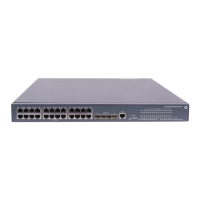2
Ste
Command
Remarks
3. Activate the current
interface.
undo shutdown
Optional.
By default, of the two ports that compose a combo
interface, the one with a smaller port ID is active.
Configuring basic settings of an Ethernet interface
You can set an Ethernet interface to operate in one of the following duplex modes:
• Full-duplex mode (full)—Interfaces that operate in this mode can send and receive packets
simultaneously.
• Half-duplex mode (half)—Interfaces that operate in this mode cannot send and receive packets
simultaneously.
• Auto-negotiation mode (auto)—Interfaces that operate in this mode negotiate a duplex mode with
their peers.
You can set the speed of an Ethernet interface or enable it to automatically negotiate a speed with its
peer. For a 100-Mbps or 1000-Mbps Ethernet interface, you can also set speed options for auto
negotiation. The two ends can select a speed only from the available options. For more information, see
"Setting speed options for auto negotiation on an Ethernet interface."
To configure an Ethernet interface:
Ste
Command
Remarks
1. Enter system view.
system-view N/A
2. Enter Ethernet
interface view.
interface interface-type
interface-number
N/A
3. Set the interface
description.
description text
Optional.
By default, the description of an interface is in the format
of interface-name Interface. For example,
GigabitEthernet1/0/1 Interface.
4. Set the duplex
mode of the
interface.
duplex { auto | full |
half }
Optional.
By default, the duplex mode is auto for Ethernet
interfaces.
The half keyword is not applicable to Ethernet copper
ports that are configured with a 1000-Mbps port speed
and fiber ports.
5. Set the port speed.
speed { 10 | 100 | 1000
| auto }
Optional.
By default, an Ethernet interface automatically
negotiates a speed with the peer.
GE (SFP) fiber ports do not support the 10 or 100
keyword. 10-GE fiber ports do not support this
command.
6. Restore the default
settings for the
interface.
default Optional.

